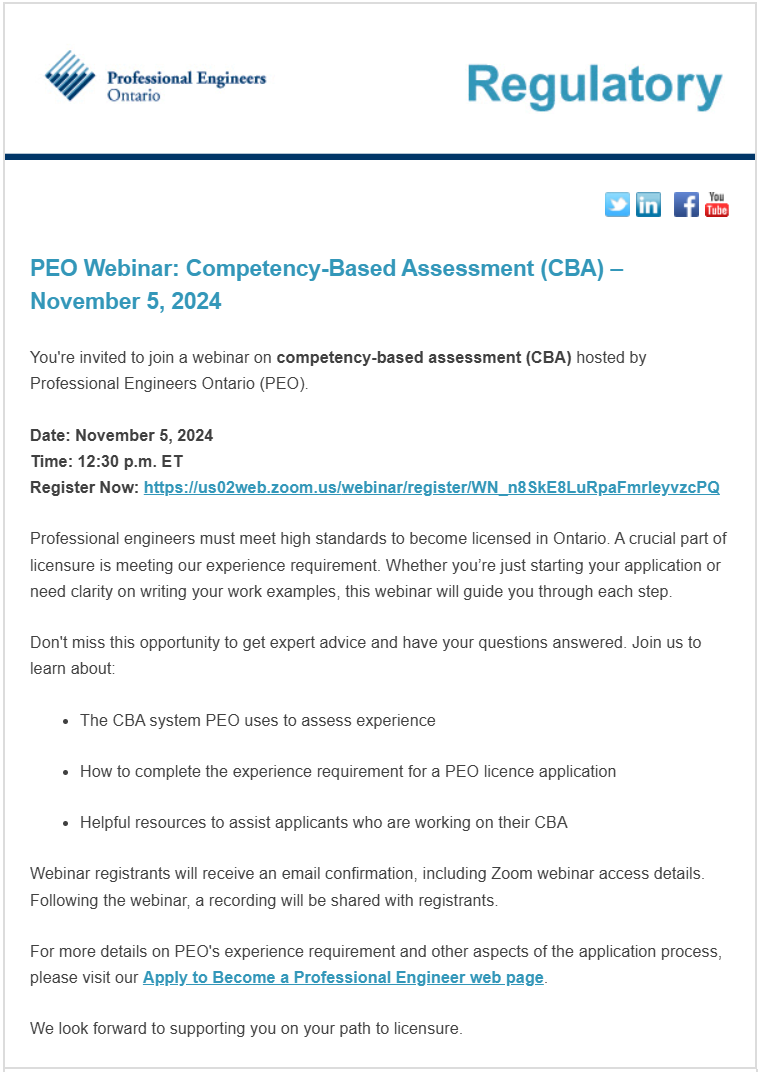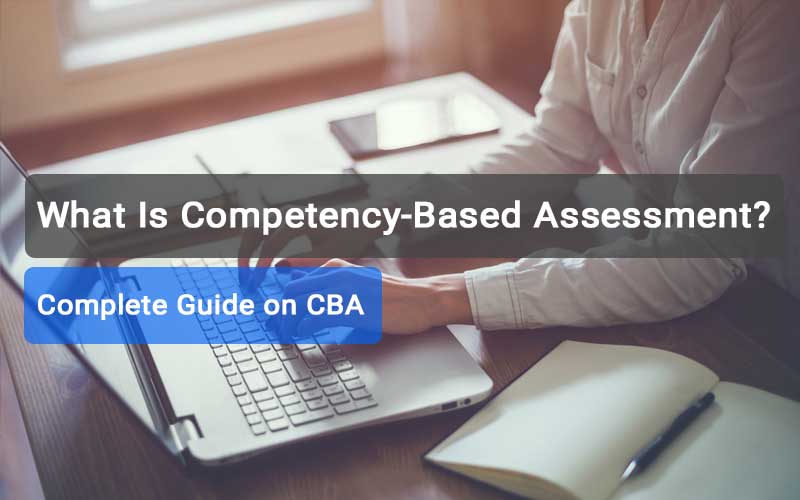Competency-Based Assessment (CBA) is a crucial step for engineering professionals aiming to obtain their Professional Engineer (PEng) license in Canada. This system allows applicants to demonstrate their engineering competence through a structured evaluation of their skills, experience, and knowledge across various competency categories. As a method designed to ensure that engineers meet the rigorous standards required for public safety and professional practice, the Competency Based Assessment process evaluates everything from technical competence to leadership, communication, and ethical responsibility. For engineers in training (EITs) or international applicants looking to become licensed in Canada, understanding the nuances of CBA is essential. This guide will help you navigate the CBA process, shed light on its importance, and explain how tools like CBA Pro can assist you in aligning your experience with the competencies needed for successful licensure.
What is CBA?
Competency Based Assessment (CBA) is a structured method used to evaluate an applicant’s engineering competencies, ensuring that they possess the essential skills required to practice as a Professional Engineer (PEng) in Canada. The CBA framework is a core part of the licensure process, designed to verify that candidates meet the high standards set by engineering regulators for public safety, ethical responsibility, and technical proficiency. It focuses not only on theoretical knowledge but also on real-world application, ensuring that an applicant can apply engineering principles in a practical, professional setting.
The CBA process involves several key steps, starting with identifying and writing down the relevant engineering competencies. After defining these competencies, candidates proceed with a self assessment, critically evaluating their own engineering experience and competencies across various categories. This self-reflection allows applicants to identify strengths and areas for improvement. Next, candidates rate their competencies on a scale from 0 to 5, reflecting their level of mastery in each competency. These competencies are grouped into categories, such as technical competence, project management, and professional accountability. Once the self-assessment is completed, applicants assign validators—qualified professionals, typically licensed P.Eng. members—to confirm the authenticity and quality of the candidate’s work experience. Validators play a crucial role by reviewing work examples, assessing their alignment with the required competencies, and providing an external validation of the applicant’s abilities. This structured assessment ensures that the applicant is ready to practice engineering in Canada, maintaining the integrity of the profession and safeguarding the public.

Purpose of the Competency-Based Assessment (CBA)
The Competency-Based Assessment (CBA) is a fundamental element of PEO’s licensure process, structured to assess whether applicants possess the engineering skills, knowledge, and professional judgment necessary for effective practice. PEO’s CEO, Jennifer Quaglietta, emphasized that this assessment is rooted in PEO’s statutory mandate to protect the public interest. By ensuring that only qualified engineers earn the license to practice in Ontario, the Competency-Based Assessment (CBA) upholds the integrity of the engineering profession and maintains high standards for public safety and professional accountability.
CBA is designed to rigorously evaluate applicants through a structured process that goes beyond basic qualifications. Applicants are required to demonstrate their ability to apply engineering principles across real-world situations, showcasing their expertise in core areas such as technical competence, communication, project management, and sustainability. This comprehensive approach allows PEO to assess candidates not only on their technical skills but also on their ability to uphold ethical and professional standards, reinforcing a culture of responsibility within Ontario’s engineering community.
In sum, Competency-Based Assessment (CBA) plays a crucial role in maintaining PEO’s commitment to public safety, serving as a transparent, consistent, and fair method to assess readiness for licensure in Ontario.
Key Components of Competency-Based Assessment (CBA)
Competency Based Assessment (CBA) is built on several key components that collectively ensure an applicant’s readiness for Professional Engineer (PEng) licensure in Canada. These components are designed to evaluate an applicant’s technical proficiency, leadership abilities, ethical judgment, and professional experience within the engineering domain. Below are the essential elements that make up the CBA process:
Competency Categories
The CBA framework assesses engineering competencies across a broad range of categories, with each category reflecting a core skill set required for successful engineering practice. The categories are carefully structured to address the various facets of engineering, including:
- Technical Competence: The ability to apply engineering principles to design, analyze, and solve problems. This includes understanding and integrating technical regulations, codes, and safety standards.
- Project and Financial Management: Competencies related to managing projects effectively, ensuring they are completed within scope, time, and budget, while maintaining high standards of quality and safety.
- Team Effectiveness: The ability to collaborate with multidisciplinary teams, resolve conflicts, and manage interpersonal dynamics to achieve project goals.
- Professional Accountability: Demonstrating a strong ethical framework, understanding the scope of professional practice, and adhering to the Code of Ethics while ensuring public safety.
Self-Assessment
A critical step in the Competency Based Assessment process, the self-assessment allows applicants to evaluate their own skills, knowledge, and experience. Engineers must review each competency category, provide detailed examples of how they have applied these competencies in their professional work, and rate their level of proficiency. The self assessment in CBA not only provides a personal reflection but also helps assessors understand the applicant’s perspective on their own competencies and readiness for independent practice.
Competency Rating Scale
Applicants are required to rate their competency levels on a scale of 0 to 5, where 0 indicates no competence, and 5 represents mastery or expert-level proficiency. This rating is crucial for the Competency-Based Assessment process as it helps evaluators gauge the applicant’s qualifications and match their experience to the requirements of each competency. The ratings also help highlight areas for development, which may require additional experience or training before licensure.
Work Examples and Documentation
A critical component of the CBA is the submission of work examples. These are detailed descriptions of real-world engineering tasks or projects that the applicant has completed. Each work example should demonstrate how the applicant applied the relevant engineering competencies, with clear evidence of the applicant’s contributions, decision-making process, and the impact of their work. These examples allow assessors to evaluate the applicant’s technical and practical experience, confirming their competence in addressing engineering challenges.
Validator Input
Validators are experienced professionals, typically licensed engineers (P.Eng.), who are assigned to review and verify the applicant’s work examples. Validators play a crucial role in assessing the validity of the applicant’s competencies and providing an independent, third-party evaluation. They must confirm that the applicant has met the required competency levels, ensuring that the engineering work submitted aligns with industry standards and regulations. Validators also help maintain the integrity of the CBA process by ensuring that applicants’ competencies are genuinely reflective of their on-the-job performance.
Final Assessment and Recommendation
After completing the self-assessment and competency ratings, applicants submit their final CBA documentation for review by the engineering regulatory body. This submission includes a comprehensive report of their competencies, work examples, and self-assessment ratings.
Once submitted, the validator review process begins, where assigned validators—typically P.Eng. members—assess the authenticity of the applicant’s work experience. Validators review the submitted competencies and provide feedback based on their direct knowledge of the applicant’s engineering tasks.
After the validation process is completed, the regulatory body will assess the documentation, including validator feedback, and determine whether the applicant has met the necessary standards for licensure. If successful, the applicant will be recommended for professional licensure.

Step-by-Step Guide to Submitting a CBA Application
Submitting your Competency-Based Assessment (CBA) application is a crucial part of obtaining your Professional Engineer (PEng) license in Canada. To ensure a smooth process and increase the likelihood of success, follow this step-by-step guide.
Step 1: Collecting and Organizing Your Work Experience into Relevant Competencies
The first step in submitting your CBA application is gathering and organizing your engineering work experience. The CBA requires you to categorize your professional experience into relevant competency categories, such as technical competence, project management, and professional accountability.
Each competency category is aligned with the skills and knowledge required for effective engineering practice in Canada. For each category, you’ll need to provide specific work examples that demonstrate your proficiency. These examples should clearly illustrate how you applied the relevant engineering principles and how your work aligns with the competency criteria.
Tip: Start early by reviewing the Competency-Based Assessment Guide and mapping your experiences to the required competencies. This will ensure you capture all the necessary details and avoid last-minute scrambling.
Step 2: Rating Your Competencies on a Scale of 0-5
Once you’ve organized your work experience, the next step is to rate your competencies. Each competency is assessed on a scale of 0 to 5, where:
- 0 represents no competence.
- 1-2 represent novice to intermediate-level proficiency.
- 3 indicates a competent, independent practitioner.
- 4-5 reflect advanced to expert-level mastery.
It’s essential to provide an honest and accurate self-assessment. The self-rating will give assessors insight into your own perspective on your abilities, helping them gauge whether your skills align with the required standards for professional licensure. Keep in mind that ratings that are too high or too low without appropriate justification can raise concerns, so be sure to back up your ratings with concrete examples of your work and decision-making.
Step 3: Submitting the Final Application
Once you have completed your self-assessment and rated your competencies, the next step is to submit your final CBA application. The application includes:
- Detailed work examples that align with the assessed competencies.
- Self-assessment ratings for each competency.
- A list of proposed validators who have firsthand knowledge of your work.
Ensure that all required documents are complete and aligned with the Competency-Based Assessment Guide before submission. The Professional Engineers Ontario (PEO) will then begin reviewing your application.
Tip: Double-check your submission for clarity and completeness. Ensure that your work examples are well-documented, your ratings are justified, and your validator feedback is included.Common Mistakes to Avoid During the Competency Based Assessment Process
Step 4: Validator Review Process
After submitting your application, the next stage involves validation. Validators are experienced engineers, typically P.Eng. members, who will review your submitted competencies and confirm the authenticity of your work experience.
Validators should have first-hand knowledge of your work and be able to assess your performance accurately. They can be supervisors, managers, mentors, or colleagues who were involved in the engineering tasks you’ve described.
Once assigned, validators will review your work examples and competencies and provide their feedback on the validity of your claims. Their insights will play a crucial role in the assessment process.
Tip: It’s recommended to consult with potential validators before submitting your application to ensure they are available and willing to provide their input
While the CBA process is straightforward, there are several common mistakes that applicants should avoid to ensure their application is successful.
Lack of Specificity in Examples
One of the most common mistakes applicants make is providing vague or generic descriptions of their work experience. To strengthen your application, ensure that each work example is detailed and quantifiable. Describe specific projects, the challenges you faced, the actions you took, and the outcomes achieved. Use metrics and data wherever possible to demonstrate the impact of your work. Avoid using broad statements that do not provide concrete evidence of your competence.
Tip: Break down your work examples into the Situation, Action, and Outcome format to ensure clarity and specificity.
Improper Validator Selection
Choosing the right validators is crucial to the success of your Competency Based Assessment application. Validators must have direct, first-hand knowledge of your work and should be able to provide an accurate and honest assessment of your competencies. Selecting individuals who were not involved in your engineering tasks, or those who lack relevant professional experience, can lead to rejected applications or unverified work experience.
Tip: Select validators who have worked with you closely on projects and are familiar with your engineering contributions. This helps ensure that your competencies are validated with strong credibility.
Overlooking the Rating System
A common pitfall during the CBA process is misrating competencies. Some applicants may rate their competencies too high or too low, which can skew the assessment. Overestimating your skills without supporting evidence may raise concerns with assessors, while underestimating your abilities could lead to missed opportunities to demonstrate your full potential.
Tip: Be honest in your self-assessment and ensure that your ratings align with the work examples and feedback from your validators. Use the Competency Rating Guide to understand the expectations for each competency level and avoid misalignment with professional standards.
By following these guidelines and avoiding common mistakes, you’ll increase your chances of submitting a successful CBA application and moving forward on your path to obtaining your PEng license in Canada.

Practical Tips for Competency Based Assessment Submission
The PEO session provided useful insights and practical tips for applicants working on their Competency-Based Assessment (CBA) submission. Here are some key recommendations to help applicants create clear, compelling work examples and streamline their submission process:
Choosing Strong Work Examples: Select examples that best demonstrate your skills for each competency. You’re not required to use separate examples for every competency; a single example may address multiple competencies if it showcases a range of skills. Tailor your descriptions to focus on the specific skills or knowledge each competency requires, even when reusing examples across different competencies.
Use a Structured Approach: Follow the “Situation, Action, Outcome” format when describing each work example. Clearly state the project or task (Situation), explain your personal contributions and methods used (Action), and describe the results and impact of your work (Outcome). Use the first person (“I”) to emphasize your direct involvement, and keep descriptions concise and focused on your own contributions.
Maintaining Confidentiality: If you’re unable to disclose specific details due to privacy reasons, use placeholders (e.g., “the client” or “the project”) rather than explicit names. The focus should remain on the skills and competencies you applied rather than on proprietary information.
Minimize Dependence on AI Tools: While you may use AI tools to check grammar and clarity, avoid relying on them for substantive editing or phrasing. PEO recommends that applicants use their own communication skills to ensure authentic representation, as communication ability is also assessed.
Keep Validators Informed: Communicate regularly with your validators and ensure they understand the Competency-Based Assessment (CBA) process, especially regarding the skills and knowledge each competency requires. This will help them provide timely, accurate feedback and validate competencies effectively. If you need to correct any validator information (e.g., an email address), update it promptly through the application portal to avoid delays.
Follow the Updated Guide and Portal Instructions: The updated applicant guide and the self-serve portal both offer clear, step-by-step instructions. Ensure you adhere to these instructions, as they can help you avoid errors and streamline your experience with the CBA submission process.
How CBA Pro Helps with the CBA Process
Navigating the Competency-Based Assessment (CBA) process can be challenging, but tools like CBA Pro are designed to simplify and streamline the experience for engineering professionals. CBA Pro is an intuitive, AI-powered platform that assists you in aligning your work experience with the required competencies for Professional Engineer (PEng) licensure. The tool helps you organize your engineering experience, identify gaps in your competencies, and provides personalized feedback to strengthen your application. With CBA Pro, you can track your progress, rate your competencies accurately, and ensure that all your work examples are aligned with the assessment criteria. Additionally, the platform offers step-by-step guidance on how to improve your self-assessment, making the entire process more efficient and ensuring you’re fully prepared to submit a comprehensive and compelling Competency Based Assessment application.
Ready to get started? Visit our CBA Pro Page to begin your CBA journey with the right support and resources.
Conclusion
The Competency-Based Assessment (CBA) is a crucial step in the process of obtaining your Professional Engineer (PEng) license in Canada. By accurately assessing your engineering competencies, the CBA ensures that you meet the high standards required for public safety and effective professional practice. With careful preparation, proper organization of your work experience, and the support of tools like CBA Pro, you can confidently navigate the Competency Based Assessment process and present a strong application. Remember to avoid common mistakes, be thorough in your self-assessment, and choose your validators wisely to ensure success. Start your journey today and take the next step toward becoming a licensed professional engineer in Canada.


